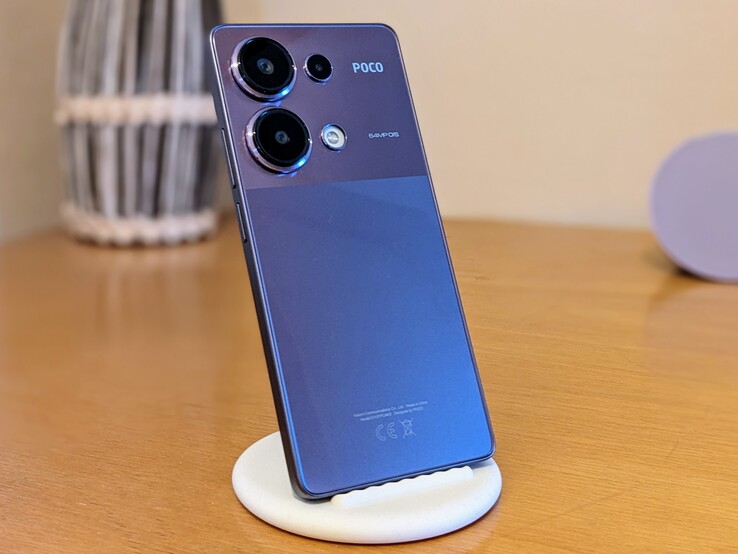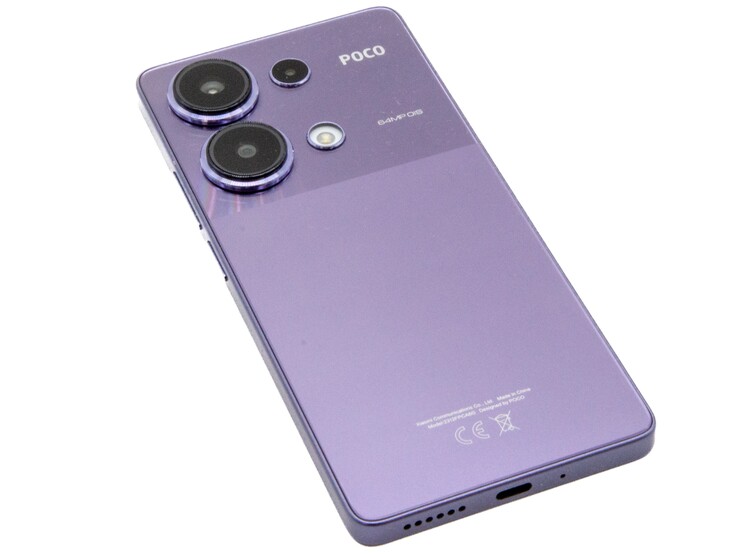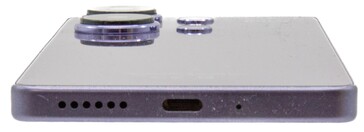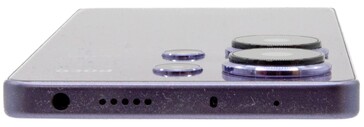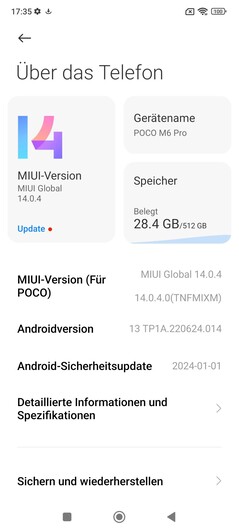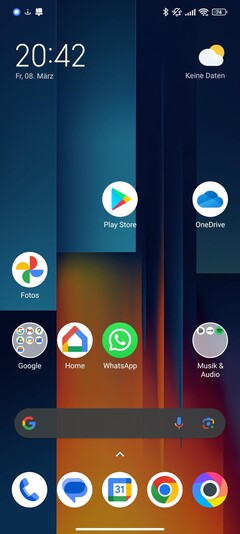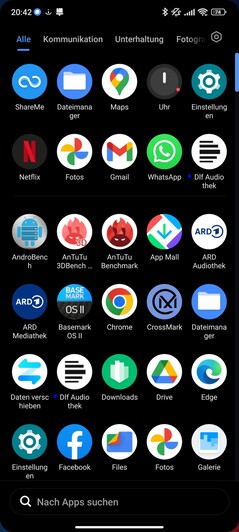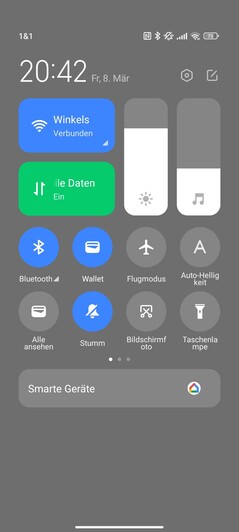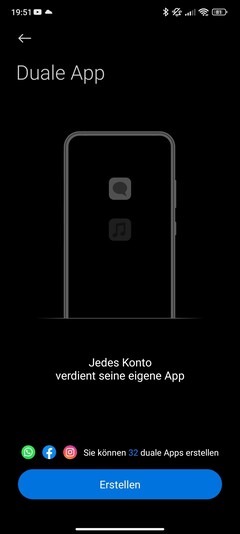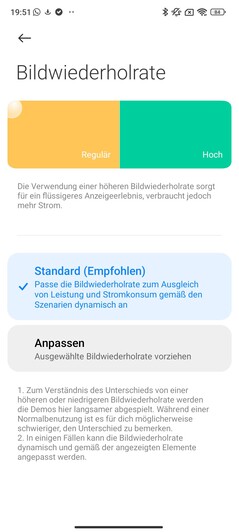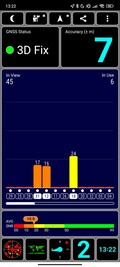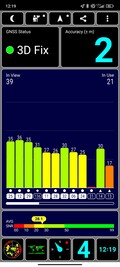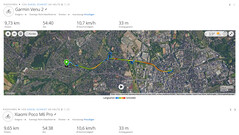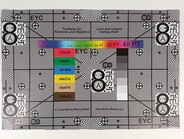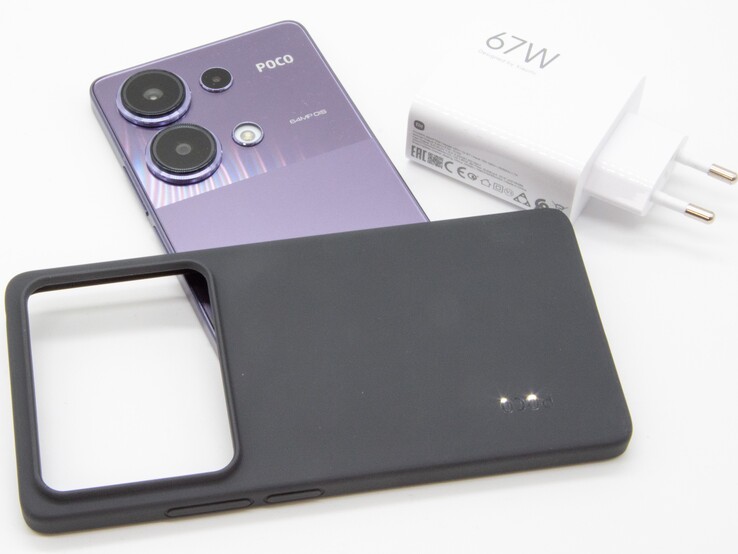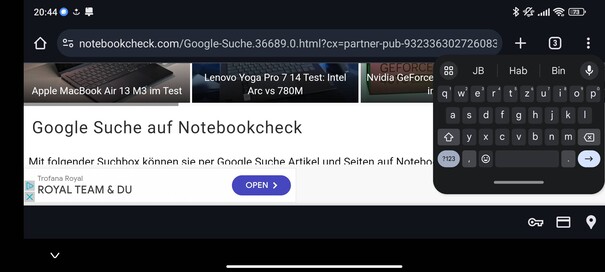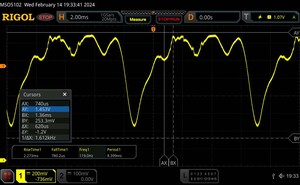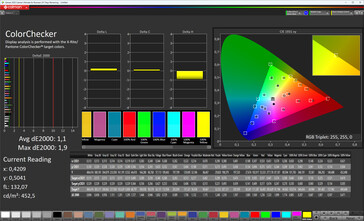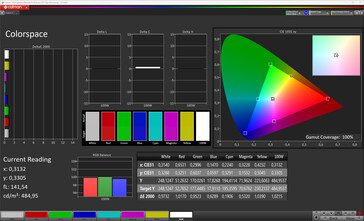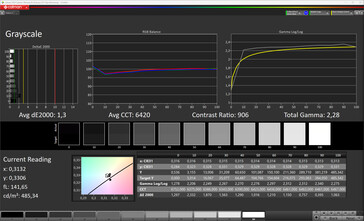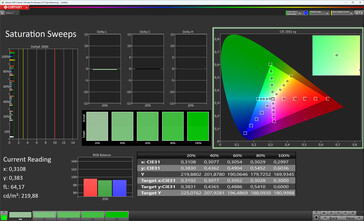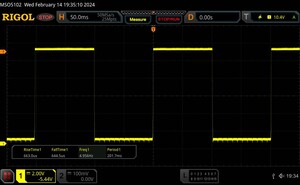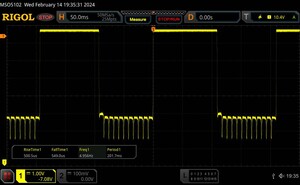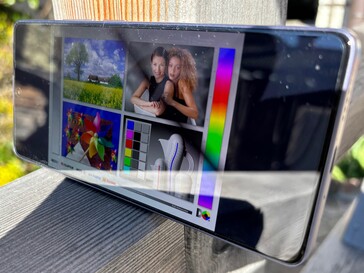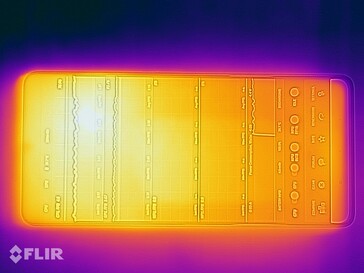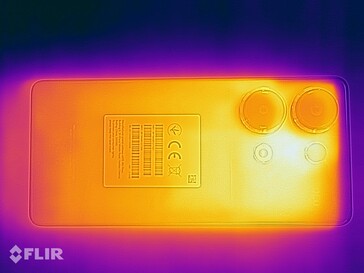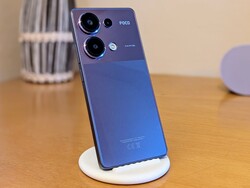Xiaomi Poco M6 Pro smartphone review - Affordable display king
The M6 Pro is advertized by Poco as a powerful device for just over US$200. There wasn't a Pro version of the M5, just an M5 and an M5s. The M5 impressed us in our test with its powerful SoC, high system performance and a 90-Hz display. It got points taken off as a result of its poor location services and missing 5G support.
The M6 is only offered by Poco as a Pro version. You can choose between 8 GB RAM and 256 GB of storage or 12 GB RAM and 512 GB of storage. The smartphones come in three colors: black, blue or purple. The small version can currently be found for US$239.99 and for the larger version, you'll have to part with around US$259. Our test device is purple and features the larger storage.
Possible competitors compared
Rating | Date | Model | Weight | Drive | Size | Resolution | Price |
|---|---|---|---|---|---|---|---|
| 81.5 % v7 (old) | 03 / 2024 | Xiaomi Poco M6 Pro Helio G99, Mali-G57 MP2 | 181 g | 512 GB UFS 2.2 Flash | 6.67" | 2400x1080 | |
| 79.4 % v7 (old) | 05 / 2023 | Samsung Galaxy A14 5G Dimensity 700, Mali-G57 MP2 | 202 g | 64 GB UFS 2.2 Flash | 6.60" | 2408x1080 | |
| 80.7 % v7 (old) | 10 / 2023 | Motorola Moto G54 Dimensity 7020, IMG BXM-8-256 | 177 g | 256 GB UFS 3.0 Flash | 6.50" | 2400x1080 | |
| 80.2 % v7 (old) | 02 / 2024 | Xiaomi Redmi Note 13 4G SD 685, Adreno 610 | 188.5 g | 128 GB UFS 2.2 Flash | 6.67" | 2400x1080 | |
| 78.9 % v7 (old) | 11 / 2022 | Xiaomi Poco M5 Helio G99, Mali-G57 MP2 | 201 g | 128 GB UFS 2.2 Flash | 6.58" | 2408x1080 |
Case - Xiaomi relies on plastic
The Poco M6 Pro's frame and back are made from plastic, resulting in a low weight of only 181 grams. Despite the material choice and low weight, the smartphone can barely be bent and is built very well. The cameras on the back stick out quite a bit, leading to the device wobbling a lot when you type on it while it sits on a table.
Its slim bezels and cleanly-installed buttons are nice. The phone's back, which is visually split in two, is striking—but it is a total dust and fingerprint magnet due to how shiny it is. Its display is covered by Corning Gorilla Glas 5. The smartphone is IP54-certified against dust and splashes of water.
Connectivity - The Poco M6 Pro with an audio jack and a microSD slot
The Poco M6 Pro's connectivity selection is good. Xiaomi has installed the Helio G99-Ultra as an SoC and, in our case, 12 GB RAM. Its 512-GB internal storage can be expanded with the help of a microSD card. It additionally features NFC support, a 3.5-mm audio jack and even an infrared blaster.
Unfortunately, its USB-C port only offers USB-2.0 speeds, but the data systems exFAT and NTFS for external storage drives are supported. In our copying test using a Samsung 980 Pro SSD, it achieved transfer rates of 26.8 MB/s.
microSD card reader
Although the Poco M6 Pro comes delivered with at least 256 GB of internal storage, it can be expanded externally using a microSD card. Cards can have a maximum size of 1 TB and they are housed within a hybrid slot. The M6 Pro masters exFAT, however, its data transfer results were quite low during our test.
Together with an Angelbird AV PRO microSD 128 GB V60 as a reference card, we measured a transfer rate of 22.1 MB/s. This makes the M6 Pro even slower than the M5. A Samsung Galaxy A14 5G is almost twice as fast.
| SD Card Reader - average JPG Copy Test (av. of 3 runs) | |
| Samsung Galaxy A14 5G (Angelbird AV Pro V60) | |
| Motorola Moto G54 (Angelbird V60) | |
| Xiaomi Poco M5 (Angelbird V60) | |
| Xiaomi Redmi Note 13 4G (Angelbird V60) | |
| Xiaomi Poco M6 Pro (Angelbird AV Pro V60) | |
Cross Platform Disk Test (CPDT)
Software - The Poco not yet with Hyper OS
The Poco M6 Pro is delivered by Xiaomi with Android 13 and MIUI 14 installed. According to the manufacturer, the Poco M6 Pro 5G is set to receive two major Android version updates and security patches lasting until September 2026. The updates should be rolled out every three months. We assume that the 4G version we are testing will receive the same updates, however, this model isn't listed within Xiaomi's update plan.
Straight out of the box, the phone comes with some Xiaomi and Google apps installed—plus, quite a few third-party apps flood the phone, such as Amazon, Aliexpress, Booking, Opera, TikTok and more. Thankfully, all of these apps can be uninstalled easily. Ex-works, 28.4 GB of the device's internal storage is already used up.
Communication and GNSS - The M6 Pro with WiFi 5 but without 5G
The Poco M6 Pro only supports WiFi 5. In combination with our reference router, the Asus ROG Rapture GT-AXE11000, our test device achieved average transfer rates for its price class, namely considerably over 300 Mbit/s. Only one major drop during the transfer clouded the picture a little.
Mobile data can be used using two physical SIM cards, whereas eSIMs aren't supported. With 19 supported LTE frequencies, its coverage in particular is good. On the other hand, the M6 Pro doesn't support 5G. During our test, we never had any reception issues.
| Networking | |
| Xiaomi Poco M6 Pro | |
| iperf3 receive AXE11000 | |
| iperf3 transmit AXE11000 | |
| Samsung Galaxy A14 5G | |
| iperf3 receive AXE11000 | |
| iperf3 transmit AXE11000 | |
| Motorola Moto G54 | |
| iperf3 receive AXE11000 | |
| iperf3 transmit AXE11000 | |
| Xiaomi Redmi Note 13 4G | |
| iperf3 receive AXE11000 | |
| iperf3 transmit AXE11000 | |
| Average of class Smartphone | |
| iperf3 receive AXE11000 | |
| iperf3 transmit AXE11000 | |
The Poco M6 Pro only achieved average results when testing its satellite connection. It supports all the major satellite systems, but only with one band each.
While its reception proved to be good outside, its accuracy plummets indoors or in more dense areas.
On our bike trip using the Garmin Venu 2 as a comparison device, this became obvious when turning around a block of houses.
Telephone features and call quality - The Poco M6 Pro doesn't have any issues
For making calls, the Xiaomi Poco M6 Pro relies on the standard telephone app from Google. The software is nice and clear and it lets you create different call accounts for different SIM cards. You can also automatically block spam calls.
Its call quality is good. We noted no background noise and all voices were transmitted clearly with the speakers also getting loud enough.
Cameras - The Poco M6 Pro needs lots of light
There are three lenses on the back of the Poco M6 Pro. Its main camera has a resolution of 64 MPix and features OIS. In good lighting conditions, the main camera's photos look fine, but they are certainly no highlight. Colors are depicted naturally but they aren't very sharp. Sharpness further declines when using the ultra-wide angle lens and some detail is lost.
Photos taken using the digital zoom and especially ones taken in low lighting conditions overwhelm the system. The software offers special modes for long-exposure shots or photos using the full 64-MPix resolution. By standard, the smartphone uses pixel binning. It also features a pro mode which lets you manually set white balance, exposure time, ISO, focus and lighting correction.
Videos can be recorded at a maximum of 1080p and 60fps. Its autofocus works quickly and reliably. Close-up shots are also possible. Despite its OIS, you need a steady hand to achieve stable videos.
Image comparison
Choose a scene and navigate within the first image. One click changes the position on touchscreens. One click on the zoomed-in image opens the original in a new window. The first image shows the scaled photograph of the test device.
RabbitLakeUltra-wide angle5x zoomLow-light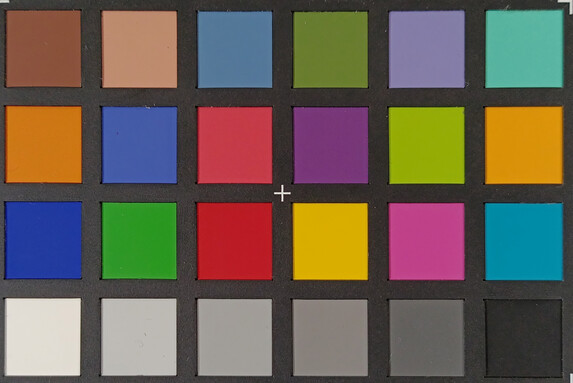

Accessoires and warranty - Xiaomi includes a case and power supply
Xiaomi has included a generous amount of accessories with the phone. Aside from the device itself, you also get a 67-watt power supply, a USB cable (USB-A to USB-C) and even a case. The phone also comes with a screen protector pre-installed. The Poco M6 Pro comes with a standard 12-month warranty.
Input devices & operation - Unlock the M6 Pro quickly
Straight out of the box, the Xiaomi Poco M6 Pro comes with the GBoard keyboard installed. This makes it possible to type without any erroneous inputs. Inputs are recognized reliably right up to the edges. At the same time, the installed screen protector doesn't get in the way and your fingers glide over the surface nicely.
You can unlock the phone using an optical fingerprint sensor that is installed within the display. Fingers were recognized reliably during our test. However, the sensor sits quite far down and it could do with being a little speedier. It is faster to use the phone's 2D facial recognition which relies on the camera—in good lighting conditions, it works really well. You can choose to skip the lock screen entirely.
A linear z-axis vibration motor takes care of the Poco M6 Pro's vibrations. It does its job quietly and subtly.
Display - The Poco M6 Pro cracks 1000 nits
Xiaomi has installed a 6.67-inch AMOLED panel into the Poco M6 Pro. In contrast to the M5, this model even has a refresh rate of 120 Hz. The rate can be fixed at 60 or 120 Hz but straight out of the box, the software takes care of this automatically. According to the DRM info, the possible levels are 60, 90 or 120 Hz.
When taking a look at the comparison devices, its maximum brightness is impressive. We measured an average maximum brightness of 1016.4 cd/m² on all measuring points with the ambient light sensor activated. The panel even reached 1289 nits in the APL18 measurement. The panel also offers a perfect black level and great contrasts thanks to its design.
During our tests, we also noticed that the display flickers. Xiaomi advertizes PWM dimming at 1920 Hz. We measured a frequency of 1612 Hz when using the lowest screen brightness. However, we measured another flicker with a frequency of 119 Hz, too. This is probably due to black frame insertion, which is used to reduce motion blur and as burn-in protection.
| |||||||||||||||||||||||||
Brightness Distribution: 94 %
Center on Battery: 1016 cd/m²
Contrast: ∞:1 (Black: 0 cd/m²)
ΔE ColorChecker Calman: 1.1 | ∀{0.5-29.43 Ø4.77}
ΔE Greyscale Calman: 1.3 | ∀{0.09-98 Ø5}
100% sRGB (Calman 2D)
Gamma: 2.28
CCT: 6420 K
| Xiaomi Poco M6 Pro AMOLED, 2400x1080, 6.7" | Samsung Galaxy A14 5G PLS LCD, 2408x1080, 6.6" | Motorola Moto G54 IPS, 2400x1080, 6.5" | Xiaomi Redmi Note 13 4G AMOLED, 2400x1080, 6.7" | |
|---|---|---|---|---|
| Screen | -304% | -138% | -9% | |
| Brightness middle (cd/m²) | 1016 | 579 -43% | 492 -52% | 940 -7% |
| Brightness (cd/m²) | 1016 | 543 -47% | 470 -54% | 922 -9% |
| Brightness Distribution (%) | 94 | 87 -7% | 90 -4% | 96 2% |
| Black Level * (cd/m²) | 0.57 | 0.3 | ||
| Colorchecker dE 2000 * | 1.1 | 7.6 -591% | 3.9 -255% | 1.2 -9% |
| Colorchecker dE 2000 max. * | 1.9 | 12.7 -568% | 6.26 -229% | 2.28 -20% |
| Greyscale dE 2000 * | 1.3 | 8.7 -569% | 4.3 -231% | 1.4 -8% |
| Gamma | 2.28 96% | 2.23 99% | 2.275 97% | 2.27 97% |
| CCT | 6420 101% | 9344 70% | 7656 85% | 6503 100% |
| Contrast (:1) | 1016 | 1640 |
* ... smaller is better
Screen Flickering / PWM (Pulse-Width Modulation)
| Screen flickering / PWM detected | 119 Hz | ||
The display backlight flickers at 119 Hz (worst case, e.g., utilizing PWM) . The frequency of 119 Hz is very low, so the flickering may cause eyestrain and headaches after extended use. In comparison: 53 % of all tested devices do not use PWM to dim the display. If PWM was detected, an average of 8084 (minimum: 5 - maximum: 343500) Hz was measured. | |||
Measurement series with fixed zoom level and different brightness settings
The Xiaomi Poco M6 Pro's display is calibrated well. Oftentimes, we noted deviations below what is perceivable by the naked eye. According to our Calman 2D measurement, the sRGB color space is covered by 100 per cent.
Display Response Times
| ↔ Response Time Black to White | ||
|---|---|---|
| 1.31 ms ... rise ↗ and fall ↘ combined | ↗ 0.663 ms rise | |
| ↘ 0.6445 ms fall | ||
| The screen shows very fast response rates in our tests and should be very well suited for fast-paced gaming. In comparison, all tested devices range from 0.1 (minimum) to 240 (maximum) ms. » 6 % of all devices are better. This means that the measured response time is better than the average of all tested devices (20.2 ms). | ||
| ↔ Response Time 50% Grey to 80% Grey | ||
| 1.05 ms ... rise ↗ and fall ↘ combined | ↗ 0.5005 ms rise | |
| ↘ 0.549 ms fall | ||
| The screen shows very fast response rates in our tests and should be very well suited for fast-paced gaming. In comparison, all tested devices range from 0.165 (minimum) to 636 (maximum) ms. » 4 % of all devices are better. This means that the measured response time is better than the average of all tested devices (31.6 ms). | ||
Performance - The same SoC as its Poco predecessor
The Xiaomi Poco M6 Pro uses a similar SoC to its predecessor, namely the MediaTek Helio G99—but now with the Ultra suffix. Its everyday performance is good. The smartphone runs smoothly and even boots up larger apps quickly. However, when taking a look at the benchmark results, we didn't measure an increase in performance; the name suffixes can vary at MediaTek.
The M6 Pro easily outperforms its corporate brother, the Xiaomi Redmi Note 13 4G with the Snapdragon 685. The Samsung Galaxy A14 5G with the MediaTek Dimensity 700 also does considerably worse.
| UL Procyon AI Inference for Android - Overall Score NNAPI | |
| Average of class Smartphone (3769 - 81594, n=132, last 2 years) | |
| Xiaomi Poco M5 | |
| Xiaomi Poco M6 Pro | |
| Average Mediatek Helio G99 (6323 - 9695, n=13) | |
| Samsung Galaxy A14 5G | |
| Motorola Moto G54 | |
| Xiaomi Redmi Note 13 4G | |
| Antutu v10 - Total Score | |
| Average of class Smartphone (142748 - 3269237, n=149, last 2 years) | |
| Xiaomi Poco M6 Pro | |
| Average Mediatek Helio G99 (383511 - 422936, n=9) | |
| Xiaomi Redmi Note 13 4G | |
The ARM Mali-G57 MP 2 graphics unit results in the Poco M6 Pro only seldomly landing right at the top of our comparison rankings. However, this was enough to secure average results and to run current games. You can play PUBG Mobile smoothly in HD with good frame rates.
The Poco M6 Pro was also on par with the comparison devices in the browser benchmarks. It gained plus points for its internal storage. It complies with the UFS 2.2 standard, is large and boasts fast transfer rates when compared to the rest of the class.
GFXBench (DX / GLBenchmark) 2.7: T-Rex Onscreen | 1920x1080 T-Rex Offscreen
GFXBench 3.0: on screen Manhattan Onscreen OGL | 1920x1080 1080p Manhattan Offscreen
GFXBench 3.1: on screen Manhattan ES 3.1 Onscreen | 1920x1080 Manhattan ES 3.1 Offscreen
GFXBench: on screen Car Chase Onscreen | 1920x1080 Car Chase Offscreen | on screen Aztec Ruins High Tier Onscreen | 2560x1440 Aztec Ruins High Tier Offscreen | on screen Aztec Ruins Normal Tier Onscreen | 1920x1080 Aztec Ruins Normal Tier Offscreen | 3840x2160 4K Aztec Ruins High Tier Offscreen
| 3DMark / Wild Life Extreme Unlimited | |
| Xiaomi Poco M6 Pro | |
| Xiaomi Poco M5 | |
| Samsung Galaxy A14 5G | |
| Xiaomi Redmi Note 13 4G | |
| Motorola Moto G54 | |
| 3DMark / Wild Life Extreme | |
| Xiaomi Poco M6 Pro | |
| Xiaomi Poco M5 | |
| Samsung Galaxy A14 5G | |
| Xiaomi Redmi Note 13 4G | |
| Motorola Moto G54 | |
| 3DMark / Wild Life Unlimited Score | |
| Xiaomi Poco M6 Pro | |
| Xiaomi Poco M5 | |
| Samsung Galaxy A14 5G | |
| Xiaomi Redmi Note 13 4G | |
| Motorola Moto G54 | |
| 3DMark / Wild Life Score | |
| Xiaomi Poco M6 Pro | |
| Xiaomi Poco M5 | |
| Samsung Galaxy A14 5G | |
| Xiaomi Redmi Note 13 4G | |
| Motorola Moto G54 | |
| 3DMark / Sling Shot Extreme (Vulkan) Unlimited Physics | |
| Motorola Moto G54 | |
| Samsung Galaxy A14 5G | |
| Xiaomi Poco M5 | |
| Xiaomi Poco M6 Pro | |
| Xiaomi Redmi Note 13 4G | |
| 3DMark / Sling Shot Extreme (Vulkan) Unlimited Graphics | |
| Motorola Moto G54 | |
| Xiaomi Poco M5 | |
| Xiaomi Poco M6 Pro | |
| Samsung Galaxy A14 5G | |
| Xiaomi Redmi Note 13 4G | |
| 3DMark / Sling Shot Extreme (Vulkan) Unlimited | |
| Motorola Moto G54 | |
| Xiaomi Poco M5 | |
| Xiaomi Poco M6 Pro | |
| Samsung Galaxy A14 5G | |
| Xiaomi Redmi Note 13 4G | |
| 3DMark / Sling Shot Extreme (ES 3.1) Unlimited Physics | |
| Xiaomi Poco M5 | |
| Xiaomi Poco M6 Pro | |
| Samsung Galaxy A14 5G | |
| Motorola Moto G54 | |
| Xiaomi Redmi Note 13 4G | |
| 3DMark / Sling Shot Extreme (ES 3.1) Unlimited Graphics | |
| Xiaomi Poco M6 Pro | |
| Xiaomi Poco M5 | |
| Motorola Moto G54 | |
| Samsung Galaxy A14 5G | |
| Xiaomi Redmi Note 13 4G | |
| 3DMark / Sling Shot Extreme (ES 3.1) Unlimited | |
| Xiaomi Poco M6 Pro | |
| Xiaomi Poco M5 | |
| Motorola Moto G54 | |
| Samsung Galaxy A14 5G | |
| Xiaomi Redmi Note 13 4G | |
| GFXBench (DX / GLBenchmark) 2.7 / T-Rex Onscreen | |
| Motorola Moto G54 | |
| Samsung Galaxy A14 5G | |
| Xiaomi Poco M6 Pro | |
| Xiaomi Poco M5 | |
| Xiaomi Redmi Note 13 4G | |
| GFXBench (DX / GLBenchmark) 2.7 / T-Rex Offscreen | |
| Motorola Moto G54 | |
| Xiaomi Poco M5 | |
| Samsung Galaxy A14 5G | |
| Xiaomi Poco M6 Pro | |
| Xiaomi Redmi Note 13 4G | |
| GFXBench 3.0 / Manhattan Onscreen OGL | |
| Motorola Moto G54 | |
| Xiaomi Poco M6 Pro | |
| Xiaomi Poco M5 | |
| Samsung Galaxy A14 5G | |
| Xiaomi Redmi Note 13 4G | |
| GFXBench 3.0 / 1080p Manhattan Offscreen | |
| Motorola Moto G54 | |
| Xiaomi Poco M5 | |
| Xiaomi Poco M6 Pro | |
| Samsung Galaxy A14 5G | |
| Xiaomi Redmi Note 13 4G | |
| GFXBench 3.1 / Manhattan ES 3.1 Onscreen | |
| Motorola Moto G54 | |
| Xiaomi Poco M6 Pro | |
| Xiaomi Poco M5 | |
| Samsung Galaxy A14 5G | |
| Xiaomi Redmi Note 13 4G | |
| GFXBench 3.1 / Manhattan ES 3.1 Offscreen | |
| Motorola Moto G54 | |
| Xiaomi Poco M6 Pro | |
| Xiaomi Poco M5 | |
| Samsung Galaxy A14 5G | |
| Xiaomi Redmi Note 13 4G | |
| GFXBench / Car Chase Onscreen | |
| Motorola Moto G54 | |
| Xiaomi Poco M6 Pro | |
| Xiaomi Poco M5 | |
| Samsung Galaxy A14 5G | |
| Xiaomi Redmi Note 13 4G | |
| GFXBench / Car Chase Offscreen | |
| Motorola Moto G54 | |
| Xiaomi Poco M5 | |
| Samsung Galaxy A14 5G | |
| Xiaomi Poco M6 Pro | |
| Xiaomi Redmi Note 13 4G | |
| GFXBench / Aztec Ruins High Tier Onscreen | |
| Motorola Moto G54 | |
| Xiaomi Poco M5 | |
| Xiaomi Poco M6 Pro | |
| Samsung Galaxy A14 5G | |
| Xiaomi Redmi Note 13 4G | |
| GFXBench / Aztec Ruins High Tier Offscreen | |
| Motorola Moto G54 | |
| Xiaomi Poco M5 | |
| Xiaomi Poco M6 Pro | |
| Samsung Galaxy A14 5G | |
| Xiaomi Redmi Note 13 4G | |
| GFXBench / Aztec Ruins Normal Tier Onscreen | |
| Motorola Moto G54 | |
| Xiaomi Poco M5 | |
| Samsung Galaxy A14 5G | |
| Xiaomi Poco M6 Pro | |
| Xiaomi Redmi Note 13 4G | |
| GFXBench / Aztec Ruins Normal Tier Offscreen | |
| Motorola Moto G54 | |
| Xiaomi Poco M5 | |
| Samsung Galaxy A14 5G | |
| Xiaomi Poco M6 Pro | |
| Xiaomi Redmi Note 13 4G | |
| GFXBench / 4K Aztec Ruins High Tier Offscreen | |
| Motorola Moto G54 | |
| Xiaomi Poco M5 | |
| Xiaomi Poco M6 Pro | |
| Samsung Galaxy A14 5G | |
| Xiaomi Redmi Note 13 4G | |
| Jetstream 2 - 2.0 Total Score | |
| Average of class Smartphone (23.8 - 387, n=147, last 2 years) | |
| Motorola Moto G54 (Chrome 118.0.5993.80) | |
| Average Mediatek Helio G99 (46.9 - 92.8, n=15) | |
| Xiaomi Poco M6 Pro (chrome 122) | |
| Xiaomi Redmi Note 13 4G (Chrome 120) | |
| Samsung Galaxy A14 5G (Chrome 112) | |
| Xiaomi Poco M5 (Chrome 107) | |
| Speedometer 2.0 - Result 2.0 | |
| Average of class Smartphone (15.2 - 643, n=119, last 2 years) | |
| Motorola Moto G54 (Chrome 118.0.5993.80) | |
| Xiaomi Poco M6 Pro (chrome 122) | |
| Average Mediatek Helio G99 (24.1 - 90.1, n=12) | |
| Xiaomi Redmi Note 13 4G (Chrome 120) | |
| Samsung Galaxy A14 5G (Chrome 112) | |
| Xiaomi Poco M5 (Chome 107) | |
| WebXPRT 4 - Overall | |
| Average of class Smartphone (27 - 306, n=143, last 2 years) | |
| Motorola Moto G54 (Chrome 118.0.5993.80) | |
| Xiaomi Poco M6 Pro (Chrome 122) | |
| Average Mediatek Helio G99 (39 - 89, n=13) | |
| Samsung Galaxy A14 5G (2111) | |
| Xiaomi Redmi Note 13 4G (Chrome 120) | |
| Xiaomi Poco M5 (Chrome 107) | |
| WebXPRT 3 - Overall | |
| Average of class Smartphone (38 - 380, n=30, last 2 years) | |
| Motorola Moto G54 (Chrome 118.0.5993.80) | |
| Average Mediatek Helio G99 (80 - 112, n=8) | |
| Xiaomi Poco M5 (Chrome 107) | |
| Octane V2 - Total Score | |
| Average of class Smartphone (2228 - 126661, n=194, last 2 years) | |
| Motorola Moto G54 (Chrome 118.0.5993.80) | |
| Xiaomi Poco M6 Pro (chrome 122) | |
| Average Mediatek Helio G99 (17228 - 26476, n=24) | |
| Xiaomi Poco M5 (Chrome 107) | |
| Xiaomi Redmi Note 13 4G (Chrome 120) | |
| Samsung Galaxy A14 5G (Chrome 112) | |
| Mozilla Kraken 1.1 - Total | |
| Xiaomi Redmi Note 13 4G (Chrome 120) | |
| Samsung Galaxy A14 5G (Chrome 112) | |
| Xiaomi Poco M5 (Chrome 107) | |
| Average Mediatek Helio G99 (1600 - 2444, n=13) | |
| Xiaomi Poco M6 Pro (chrome 122) | |
| Motorola Moto G54 (Chrome 118.0.5993.80) | |
| Average of class Smartphone (257 - 28190, n=154, last 2 years) | |
* ... smaller is better
| Xiaomi Poco M6 Pro | Samsung Galaxy A14 5G | Motorola Moto G54 | Xiaomi Redmi Note 13 4G | Average 512 GB UFS 2.2 Flash | Average of class Smartphone | |
|---|---|---|---|---|---|---|
| AndroBench 3-5 | -23% | -3% | -16% | 5% | 78% | |
| Sequential Read 256KB (MB/s) | 973.53 | 849.3 -13% | 983.01 1% | 909.8 -7% | 1026 ? 5% | 2235 ? 130% |
| Sequential Write 256KB (MB/s) | 910.9 | 469.83 -48% | 817.55 -10% | 606.3 -33% | 930 ? 2% | 1871 ? 105% |
| Random Read 4KB (MB/s) | 236.72 | 193.63 -18% | 232.74 -2% | 177.1 -25% | 234 ? -1% | 297 ? 25% |
| Random Write 4KB (MB/s) | 228.61 | 204 -11% | 224.58 -2% | 228 0% | 261 ? 14% | 343 ? 50% |
Emissions - The Poco M6 Pro is stable
Temperature - The Poco M6 Pro keeps its cool
The Xiaomi Poco M6 Pro's temperatures ranged within a normal field. We measured a maximum temperature of 39.6 degrees Celsius on the front. These values can unfortunately barely be compared with the comparison devices, as we switched to the Burnout benchmark for our measurements.
In everyday use, the device stays cool. Only when playing games do you notice it starts to get warm but it never reaches uncomfortable temperatures.
(+) The maximum temperature on the upper side is 39.4 °C / 103 F, compared to the average of 35.2 °C / 95 F, ranging from 21.9 to 247 °C for the class Smartphone.
(+) The bottom heats up to a maximum of 37.1 °C / 99 F, compared to the average of 34 °C / 93 F
(+) In idle usage, the average temperature for the upper side is 27.1 °C / 81 F, compared to the device average of 32.9 °C / 91 F.
3DMark Wild Life Stress Test
| 3DMark | |
| Wild Life Stress Test Stability | |
| Xiaomi Poco M6 Pro | |
| Samsung Galaxy A14 5G | |
| Wild Life Extreme Stress Test | |
| Xiaomi Poco M6 Pro | |
| Samsung Galaxy A14 5G | |
Speakers - Dolby Atmos on the Poco M6 Pro
When it comes to audio capabilities, the Poco M6 Pro shows its strengths. Aside from stereo speakers, it also features a Dolby Atmos certification and a 3.5-mm audio jack. We noted a signal-to-noise ratio of 85.31 dBFS, meaning it can be classified as good. Even at full volume, the speakers do not distort the sound. The rear remains free of vibrations, although these do occur in the phone's frame.
However, its sound doesn't have much depth. The mids are balanced, but the highs are overemphasized, while there is hardly any bass or low frequencies in general. The Poco M6 Pro supports the following Bluetooth codecs: SBC, AAC, aptX Audio, aptX HD, LDAC, aptX Adaptive Audio and aptX TWS+ Audio.
Xiaomi Poco M6 Pro audio analysis
(+) | speakers can play relatively loud (91.1 dB)
Bass 100 - 315 Hz
(-) | nearly no bass - on average 28.7% lower than median
(+) | bass is linear (5.7% delta to prev. frequency)
Mids 400 - 2000 Hz
(±) | reduced mids - on average 6.4% lower than median
(+) | mids are linear (5.9% delta to prev. frequency)
Highs 2 - 16 kHz
(+) | balanced highs - only 2.3% away from median
(+) | highs are linear (3.3% delta to prev. frequency)
Overall 100 - 16.000 Hz
(±) | linearity of overall sound is average (18.5% difference to median)
Compared to same class
» 20% of all tested devices in this class were better, 9% similar, 71% worse
» The best had a delta of 11%, average was 35%, worst was 134%
Compared to all devices tested
» 41% of all tested devices were better, 8% similar, 52% worse
» The best had a delta of 4%, average was 24%, worst was 134%
Samsung Galaxy A14 5G audio analysis
(+) | speakers can play relatively loud (90.4 dB)
Bass 100 - 315 Hz
(-) | nearly no bass - on average 33.8% lower than median
(+) | bass is linear (4% delta to prev. frequency)
Mids 400 - 2000 Hz
(±) | reduced mids - on average 6.1% lower than median
(+) | mids are linear (5.5% delta to prev. frequency)
Highs 2 - 16 kHz
(+) | balanced highs - only 4.1% away from median
(+) | highs are linear (2% delta to prev. frequency)
Overall 100 - 16.000 Hz
(±) | linearity of overall sound is average (19.9% difference to median)
Compared to same class
» 32% of all tested devices in this class were better, 7% similar, 61% worse
» The best had a delta of 11%, average was 35%, worst was 134%
Compared to all devices tested
» 50% of all tested devices were better, 7% similar, 42% worse
» The best had a delta of 4%, average was 24%, worst was 134%
Battery life - The Poco charges quickly
Power consumption - The M6 Pro is thirsty under load
The comparatively powerful processor within the Poco M6 Pro has two sides. In idle mode, it boasts low power consumption values. However, when placed under load, the Poco M6 Pro uses quite a bit more power than its competitors.
| Off / Standby | |
| Idle | |
| Load |
|
Key:
min: | |
| Xiaomi Poco M6 Pro 5000 mAh | Samsung Galaxy A14 5G 5000 mAh | Motorola Moto G54 5000 mAh | Xiaomi Redmi Note 13 4G 5000 mAh | Xiaomi Poco M5 5000 mAh | Average Mediatek Helio G99 | Average of class Smartphone | |
|---|---|---|---|---|---|---|---|
| Power Consumption | -8% | 13% | 1% | -2% | -59% | -20% | |
| Idle Minimum * (Watt) | 1 | 0.64 36% | 0.9 10% | 1.1 -10% | 0.9 10% | 1.565 ? -57% | 0.847 ? 15% |
| Idle Average * (Watt) | 1.19 | 2.1 -76% | 1.2 -1% | 1.3 -9% | 1.3 -9% | 2.66 ? -124% | 1.448 ? -22% |
| Idle Maximum * (Watt) | 1.33 | 2.17 -63% | 1.5 -13% | 1.5 -13% | 1.9 -43% | 2.93 ? -120% | 1.633 ? -23% |
| Load Average * (Watt) | 6.27 | 3.73 41% | 3.3 47% | 3.6 43% | 4.6 27% | 5.44 ? 13% | 6.96 ? -11% |
| Load Maximum * (Watt) | 7.19 | 5.44 24% | 5.6 22% | 7.8 -8% | 6.8 5% | 7.81 ? -9% | 11.3 ? -57% |
* ... smaller is better
Power consumption: Geekbench (150 cd/m²)
Power consumption: GFXBench (150 cd/m²)
Runtimes - The Poco M6 Pro is class-average
Thanks to its 5000 mAh battery, the Xiaomi Poco M6 Pro achieves good runtimes. In our realistic WiFi web surfing test, the smartphone lasted over 14 hours. This is a good result, but other devices in this class ran for even longer. The Poco M5 also performed slightly better in the test.
The smartphone can safely last a day without needing to be charged in between—except during extensive gaming sessions. With low usage, you can also go for two days without needing to recharge the device. Charging is nice and fast thanks to its 67-watt charger—all the better that it is even included with the phone. The M6 Pro can be charged from 0 to 30 per cent in 10 minutes when connected to the power supply unit. A full charge from 0 to 100 per cent takes 50 minutes.
| Battery runtime - WiFi v1.3 | |
| Xiaomi Poco M6 Pro | |
| Samsung Galaxy A14 5G | |
| Motorola Moto G54 | |
| Xiaomi Redmi Note 13 4G | |
| Xiaomi Poco M5 | |
Pros
Cons
Verdict - The Poco M6 Pro delivers great connectivity for its money
Xiaomi has turned its Poco M6 into a Pro model. Under the hood, not much has changed, as the manufacturer continues to rely on the same SoC as the previous model featured. Even so, the phone's performance is great—as shown in the benchmarks and in everyday use. The Poco M6 Pro packs enough power to run current games such as PUBG Mobile.
In addition, the Poco M6 Pro boasts a 6.67-inch AMOLED display. It can reach brightness levels of over 1,000 nits and depicts colors accurately. This means the Xiaomi smartphone can confidently assert itself against similarly-priced competitors. Extra plus points are gained through its large internal storage and generous RAM.
It's also nice to see that Xioami hasn't made any cuts when it comes to the device's connectivity. The Poco M6 Pro features NFC, stereo speakers, an audio jack, an infrared blaster and the option to expand its storage via a microSD card.
The Poco M6 Pro offers lots of connectivity for little money. Its strengths lie in performance and display.
This much light doesn't come without some shade. Unfortunately, the Poco M6 Pro isn't 5G ready. Its satellite locating capabilities could be better, too. Its USB and microSD card transfer rates are poor. The Poco M6 Pro's camera isn't necessarily a highlight, either. Although photos taken using its main camera look fine in good lighting conditions, they are missing detail. This becomes even more noticeable when using the other lenses.
The Motorola Moto G54 offers a slimmer OS, 5G support and a better-performing camera. In turn, it has a dimmer IPS display and not as much storage space. The Samsung Galaxy A14 5G has a faster SD card connection and longer software support, but it doesn't perform nearly as well.
Price and availability
The Xiaomi Poco M6 Pro is currently on offer on Amazon for US$219.99.
Xiaomi Poco M6 Pro
- 03/12/2024 v7 (old)
Benedikt Winkel
Transparency
The selection of devices to be reviewed is made by our editorial team. The test sample was provided to the author as a loan by the manufacturer or retailer for the purpose of this review. The lender had no influence on this review, nor did the manufacturer receive a copy of this review before publication. There was no obligation to publish this review. As an independent media company, Notebookcheck is not subjected to the authority of manufacturers, retailers or publishers.
This is how Notebookcheck is testing
Every year, Notebookcheck independently reviews hundreds of laptops and smartphones using standardized procedures to ensure that all results are comparable. We have continuously developed our test methods for around 20 years and set industry standards in the process. In our test labs, high-quality measuring equipment is utilized by experienced technicians and editors. These tests involve a multi-stage validation process. Our complex rating system is based on hundreds of well-founded measurements and benchmarks, which maintains objectivity. Further information on our test methods can be found here.




